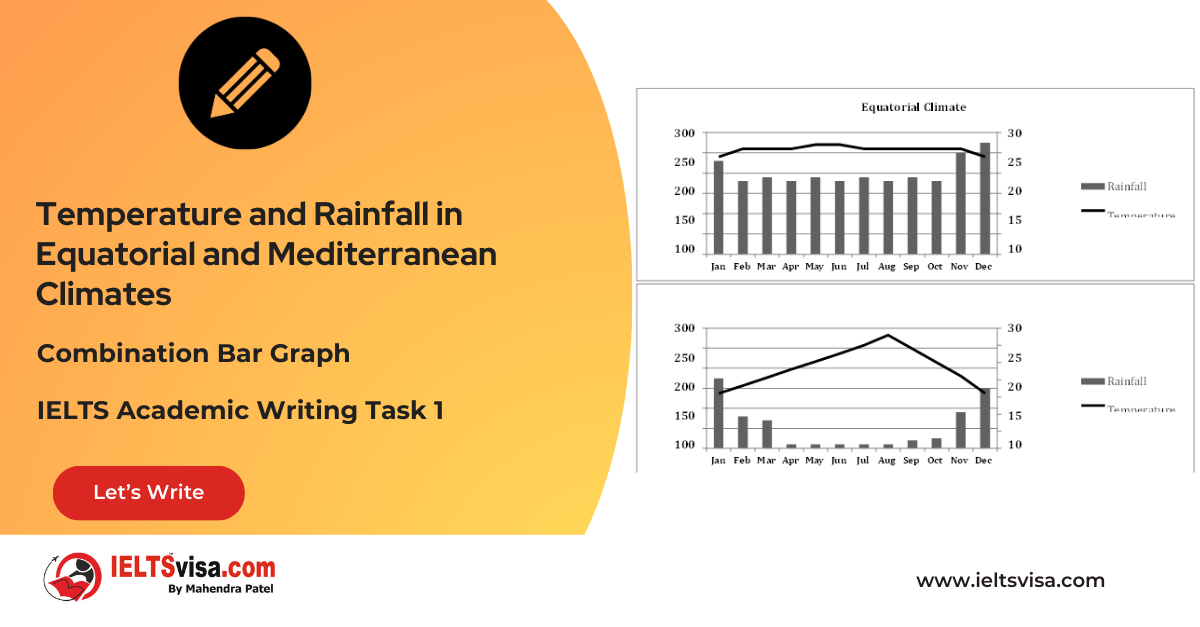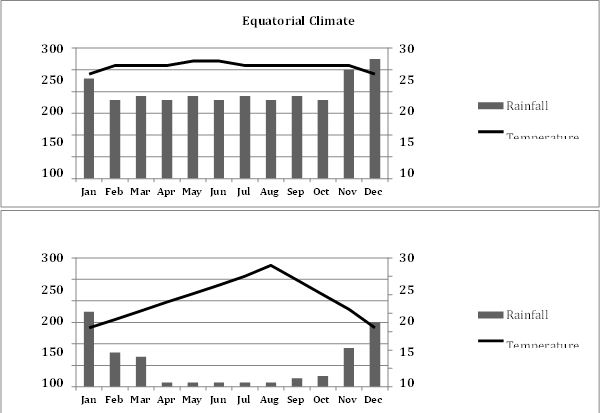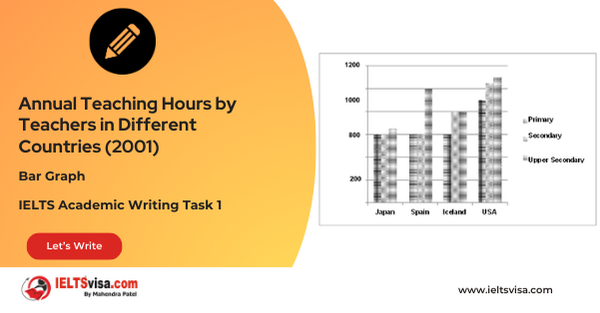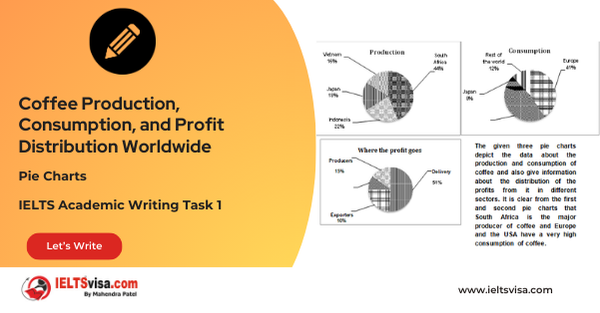Temperature and Rainfall in Equatorial and Mediterranean Climates
IELTS Academic Writing Task 1 - Combination Bar Graph
IELTS Writing Task 1 Question
The charts below show temperature and rainfall in Equatorial climate and Mediterranean climate

Common Questions for the Climate Temperature and Rainfall Charts
1. Graph Types: Column graphs
2. Title: Temperature and Rainfall in Equatorial and Mediterranean Climates
3. What are the units of measurement?: Millimeters (mm) for rainfall and degrees Celsius (°C) for temperature
4. Who: Climatologists, environmental scientists, or anyone studying climate patterns
5. When: Not specified (data for unspecified months in a year)
6. Where: Equatorial and Mediterranean regions
7. Topic: Comparison of temperature and rainfall in two different climates
Key Features of the Climate Data
1. Rainfall Patterns:
- Equatorial Climate:
- Wettest months are November, December, and January, with rainfall between 230 and 270 mm.
- Rainfall in other months fluctuates between 180 and 190 mm, indicating consistent precipitation throughout the year.
- Mediterranean Climate:
- Maximum rainfall occurs in January at around 170 mm, followed by December at 150 mm.
- February, March, and November receive moderate rainfall (70–90 mm), while other months are relatively dry, with rainfall below 20 mm.
2. Temperature Trends:
- Equatorial Climate:
- Temperature remains stable year-round, ranging from 24°C to 26°C, with May and June slightly hotter.
- Mediterranean Climate:
- Starts at around 11°C in January, gradually rising to a peak of 28°C in August, before dropping back to 11°C by December.
Overall Summary
The column graphs illustrate the temperature and rainfall patterns of Equatorial and Mediterranean climates.
In the Equatorial climate, the rainfall is notably higher, with the wettest months being November, December, and January, experiencing between 230 mm and 270 mm of rain. The temperature remains relatively stable throughout the year, consistently ranging between 24°C and 26°C, with minor peaks in May and June.
Conversely, the Mediterranean climate exhibits a marked seasonal variation in both temperature and rainfall. The highest rainfall is recorded in January at around 170 mm, while the driest months see rainfall levels below 20 mm. Temperature ranges from a low of 11°C in January to a high of 28°C in August, demonstrating a significant fluctuation across the seasons.
In conclusion, the Equatorial climate is characterized by higher temperatures and consistent rainfall, while the Mediterranean climate is cooler and experiences more pronounced seasonal variations in both temperature and precipitation.
Sample Answer
The column graphs compare temperature and rainfall in two distinct climates: Equatorial and Mediterranean.
Overall, cooler temperatures and lower rainfall characterize the Mediterranean climate compared to the Equatorial climate, which features consistently high temperatures and abundant precipitation year-round.
In the Equatorial climate, November, December, and January are the wettest months, with rainfall reaching between 230 mm and 270 mm. In contrast, rainfall in the remaining months fluctuates between 180 mm and 190 mm, demonstrating a consistent precipitation pattern throughout the year. The temperature in this climate is fairly stable, ranging from 24°C to 26°C, with May and June slightly warmer than the rest of the months.
The Mediterranean climate experiences its highest rainfall in January, measuring around 170 mm, followed by December at 150 mm. February, March, and November have moderate rainfall, ranging from 70 mm to 90 mm, while the other months are relatively dry, with rainfall levels dropping below 20 mm. The temperature in the Mediterranean climate starts at approximately 11°C in January, gradually increasing to a peak of 28°C in August before falling back to 11°C by December.
Top 25 Vocabularies
| Vocabulary (type) | Meaning | Synonyms | Examples |
|
Precipitation (noun) |
Any form of water that falls from clouds |
Rainfall, moisture |
“Equatorial climates experience high precipitation levels.” |
|
Fluctuate (verb) |
To vary or change the level |
Vary, oscillate |
“Rainfall levels fluctuate in the Mediterranean climate.” |
|
Consistent (adj) |
Constant, unchanging |
Steady, uniform |
“Equatorial temperatures remain consistent throughout the year.” |
|
Maximum (adj) |
The greatest amount or degree |
Highest, peak |
“January experiences maximum rainfall in the Mediterranean climate.” |
|
Characterize (verb) |
To describe the distinctive nature or features |
Define, distinguish |
“The Equatorial climate is characterized by high temperatures.” |
|
Climate (noun) |
The weather conditions in a region over a long period |
Weather, atmosphere |
“The Mediterranean climate is characterized by cooler temperatures.” |
|
Distinct (adjective) |
Clearly different or unique |
Separate, unique |
“The two climates are distinct in terms of rainfall and temperature patterns.” |
|
Abundant (adjective) |
Present in large quantities |
Plentiful, copious |
“The Equatorial climate has abundant precipitation year-round.” |
|
Stable (adjective) |
Unchanging or steady over time |
Constant, fixed |
“The temperature in the Equatorial climate remains stable throughout the year.” |
|
Peak (noun) |
The highest or maximum point |
Summit, zenith |
“The temperature peaks in August in the Mediterranean climate.” |
|
Demonstrate (verb) |
To show or exhibit something clearly |
Indicate, reveal |
“The rainfall pattern demonstrates consistency in the Equatorial climate.” |
|
Gradual (adjective) |
Happening slowly over time |
Steady, progressive |
“The Mediterranean temperature shows a gradual increase towards August.” |
|
Moderate (adjective) |
Average in amount or intensity |
Reasonable, mild |
“Rainfall in February is moderate in the Mediterranean climate.” |
|
Range (verb) |
To vary within a specific scope |
Span, extend |
“The temperature ranges from 11°C to 28°C in the Mediterranean climate.” |
|
Seasonal (adjective) |
Relating to or varying with the seasons |
Periodic, cyclical |
“The Mediterranean climate exhibits seasonal variations in rainfall.” |
|
Dry (adjective) |
Lacking moisture |
Arid, parched |
“The Mediterranean climate experiences dry months during summer.” |
|
Consistently (adverb) |
Happening in the same way over time |
Uniformly, steadily |
“The Equatorial climate is consistently warm throughout the year.” |
|
Abnormal (adjective) |
Deviating from the normal or expected |
Unusual, irregular |
“Abnormal rainfall patterns are rare in the Equatorial climate.” |
|
Trend (noun) |
A general direction in which something is developing |
Pattern, tendency |
“A clear trend of high rainfall is observed in the Equatorial climate.” |
|
Moderation (noun) |
The state of being within reasonable limits |
Balance, restraint |
“Rainfall in November in the Mediterranean climate is within moderation.” |
|
Distinctive (adjective) |
Clearly different or unique |
Unique, identifying |
“The Mediterranean climate has distinctive dry summers.” |
|
Warmth (noun) |
The quality of being warm |
Heat, mildness |
“The Equatorial climate maintains a sense of warmth throughout the year.” |
|
Fluctuation (noun) |
Irregular rise and fall in number or amount |
Variation, oscillation |
“Fluctuations in Mediterranean rainfall are more pronounced than in the Equatorial climate.” |
|
Pattern (noun) |
A repeated or regular arrangement |
Design, trend |
“Rainfall patterns differ significantly between the two climates.” |
|
Variation (noun) |
A change or slight difference in condition |
Change, deviation |
“The Mediterranean climate shows variation in both rainfall and temperature.” |

Our Books
Master IELTS Speaking Part 1
IELTS Writing Task 1 Book
IELTS Writing Task 2 Book
Practice IELTS Other Modules
IELTS Listening
The IELTS Listening test assesses how well you can understand spoken English in various contexts. It lasts about 30 minutes and is divided into four sections with a total of 40 questions. The listening tasks become increasingly difficult as the test progresses.
IELTS Academic Reading
The IELTS Academic Reading section assesses your ability to understand and interpret a variety of texts in academic settings. It is designed to evaluate a range of reading skills, including skimming for gist, reading for main ideas, reading for detail, understanding inferences, and recognizing a writer's opinions and arguments.
IELTS Speaking
The IELTS Speaking test assesses your ability to communicate in English on everyday topics. It lasts 11-14 minutes and consists of three parts: introduction, cue card, and a discussion based on the cue card topic.
IELTS General Reading
IELTS General Reading tests your ability to understand and interpret various types of texts. Here are some key areas and types of content you can expect to encounter in the reading section, along with tips for effective preparation.
IELTS Academic Writing Task 1
In IELTS Academic Writing Task 1, you are presented with a visual representation of information, such as graphs, charts, tables, or diagrams, and you are required to summarize, compare, or explain the data in your own words.
IELTS General Writing Task 1
In IELTS General Writing Task 1, you are required to write a letter based on a given situation. The letter can be formal, semi-formal, or informal, depending on the prompt. Here’s a breakdown of the key components to include in your letter
IELTS Academic Writing Task 2
In IELTS Academic Writing Task 2, you are required to write an essay in response to a question or topic. Here’s a guide to help you understand the essential elements of this task
IELTS Exam Tips
To succeed in the IELTS exam, practice regularly, familiarize yourself with the test format, improve your vocabulary, develop time management skills, and take mock tests to build confidence.
Grammer for IELTS
Grammar is the foundation of effective communication in English. Understanding tense usage, subject-verb agreement, and sentence structure enhances clarity and coherence in writing and speaking.
Vocabulary for IELTS
Vocabulary plays a crucial role in the IELTS (International English Language Testing System) exam, especially in the Speaking and Writing sections. Here’s an overview of why vocabulary is important and how it impacts your performance
RECENT IELTS SAMPLES QUESTIONS AND ANSWERS
Task 1 – Column graph – Percentage of Young People Enrolled in Universities in 2000 and 2007.
20:00 Start Pause Stop [df_adh_heading title_infix="IELTS Writing Task 1 Question" use_divider="on"...
Task 1 – Bar Graph – Annual Teaching Hours by Teachers in Different Countries (2001)
20:00 Start Pause Stop [df_adh_heading title_infix="IELTS Writing Task 1 Question" use_divider="on"...
Task 1 – Pie Charts – Coffee Production, Consumption, and Profit Distribution Worldwide
20:00 Start Pause Stop [df_adh_heading title_infix="IELTS Writing Task 1 Question" use_divider="on"...
Task 1 – Column graph – Types of Transport Used by Tourists Visiting New Zealand from Five Countries in 2004.
20:00 Start Pause Stop [df_adh_heading title_infix="IELTS Writing Task 1 Question" use_divider="on"...
Task 1 – Bar and Pie Chart Combination – Employment Types in 1998 and 2001
20:00 Start Pause Stop [df_adh_heading title_infix="IELTS Writing Task 1 Question" use_divider="on"...
Task 1 – Diagram – Comparison of Stone Tool Development Over Time
20:00 Start Pause Stop [df_adh_heading title_infix="IELTS Writing Task 1 Question" use_divider="on"...













